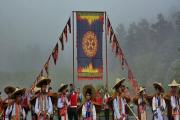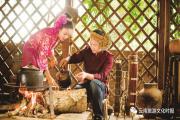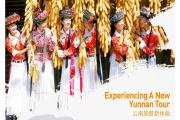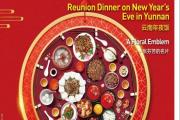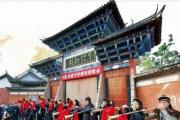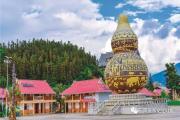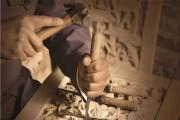![]()
![]()
EVENTS | 动态
![]()
![]()
![]()
FOCUS | 焦点
How Yunnan’s ethnic minorities celebrate Spring Festival
云南春节民族风
![]()
![]()
![]()
Chinese New Year is the most celebrated festival in China. 25 ethnic minortity groups inhabit in Yunnan, among which 15 are exclusively indigenous. Each ethnic group celebrates the new year idiosyncratically, such as the most ancient traditional and mystic sacrifices of Yi ethnic group, worship of Mountain Deity and fetching the ‘new’ fire of Wa ethnic group, the expressive Lusheng (a musical instrument withmultiple bamboo pipes) singing and dancing of Lahu ethnic group, “Damei Kongpu” gathering and rice cakes of Naxi ethnic group, etc. — all ignite the festive atmosphere.
春节是中国民间最隆重的节日。云南共有25 个少数民族,特有民族15 个,各民族都有着各自迎接春节的表达方式:彝族有最具古老传统和神秘感的祭祀,佤族有辞旧迎新的“请山神”“取新火”,拉祜族有最能表达传统文化和情感的芦笙歌舞,纳西族有“大美空普”盛会、舂粑粑……丰富多彩的年俗形式,让云南的春节更加热闹喜庆,风情万种。
![]()
Village | 村寨
Nanben: A waterside Dai village
南本:水乡傣寨
![]()
Driving 59 km along Simao-Lancang Highway from Pu’er City located in southwest Yunnan, we reached Nanben Village. Surrounded by mountains, the village is built on the mountainside, its houses scattered like stars in the sky. Nanben, in the most southern part of Longtan Village, Simao District, dates back to 1254 AD, when it was governed by chieftain of Liushun.
从普洱市区出发,沿思澜公路行驶59 公里,南本到了。定睛一看,整个村寨群星洒落般依山倾斜,四周高山环绕。南本,是普洱市思茅区龙潭乡最南的一个寨子,建于1254 年,距今762年历史,古时归六顺土司管辖。
![]()
INHERITORS | 传承者
Wang Chongming, Birdcage-carving enthusiast
王重明 玩鸟笼的人
![]()
![]()
Having been making birdcages for more than 40 years, Wang Chongming is picky about the materials. He generally uses “pinkgolden bamboo” for the main body, assembled with carved box wood components. He makes the entire birdcage himself, including the cage, carvings, a silver hook and various accessories. His exquisitely made birdcages are eagerly sought after by collectors from Taiwan of China and Singapore.
王重明制作鸟笼40多年,用料讲究,主体材料用的是一种名叫“粉金竹”的竹子,其中的雕刻件用旱黄杨木,做笼、雕刻、银挂钩、配件全部由他自己一人完成。他做的鸟笼工艺精巧,被中国台湾、新加坡等地的鸟笼爱好者竞相收藏。
![]()
HISTORICAL RELICS | 博物
Stories behind the Ox-Tiger Bronze Table
牛虎铜案
![]()
In the 1980s, there was such a saying in the circles of cultural relics and museums that “there is Galloping Horse Treading on a Flying Swallow in the north, and Ox-Tiger Bronze Table in the south”. Ox-Tiger Bronze Table was unearthed from a graveyard at Lijiashan Village, Jiangchuan County in central Yunnan’s Yuxi City, and is now considered the most valuable treasure in the collection of Yunnan Provincial Museum.
上世纪80 年代,在中国文博界曾流传这样一句话:“北有马踏飞燕,南有牛虎铜案。” 其中的“牛虎铜案”指的就是出土于云南省江川县李家山墓葬群的一件青铜器,现存于云南省博物馆,并成为该馆的“镇馆之宝”。
ART | 艺术
![]()
Illustrator Wen Yi experienced the feeling of being an internet celebrity as his drawings went viral on social apps including Wechat. What so special about his drawings, also known as “Pen and ink watercolor sketch”, is that they are drawn on discarded cardboards Wen Yi collected in Dali old town. Wen Yi outlines an image by fountain pen and then paints the sketch with watercolours — a painting method adopted by plentiful artists in recording urban changes. “Art is not an unreachable luxury. Its charm comes from the very bottom of people’s life, even the trash bins,”he said.
插画师文抑一度体验了一把做“网红”的感觉,因为在大理古城拾捡被丢弃的废纸板作画,文抑一时间火遍了朋友圈。他说“艺术并不高高在上,它可以生活在人们的脚下,甚至在垃圾堆里,这才是艺术的高尚之处”。
![]()
CITY LIFE | 城事
Running to a new height
跑出新高度
![]()
December 17, 2016 was a warm day in Kunming, the capital city of Yunnan Province because of the presence of over 16,000 domestic and foreign runners. On that day, 2016 Shanghai Cooperation Organization (SCO) Kunming International Marathon kicked off as scheduled. Faces with bright smiles were seen everywhere beside Dianchi Lake, at the foot of Xishan Mountain or in wetland parks, where the full/half marathon race and race of 12.5km were held.
2016 年12 月17 日的昆明,因为16000 余名来自国内外的跑者而变得格外温暖。当天,2016年上合昆明国际马拉松赛如期开幕,滇池边,西山脚下,湿地公园,无论是全程马拉松、半程马拉松还是12.5 公里跑的比赛,都能看到一张张温暖而灿烂的笑脸。
![]()
SOUVENIRS | 云南礼物
Dai-style pottery: Pottery with belief
傣陶:有信仰的陶
![]()
![]()
Dai-style pottery has always had two functions, either as utilitarian household vessels or religious ritual props. For the latter, Dai people have decorated the roofs and ridges of Buddhist monasteries with different types of pottery, showing their worship to nature and deities. Dai-style pottery, modeled after plants and animals, are used to decorate religious architectures. These pottery articles reflect people’s reverence and pious wishes, and are regarded with divinity. Closely linked to daily lives and religious beliefs of the Dai people, Dai pottery is one of the few pottery styles worldwide that can be called “pottery with belief ”.
从一开始,傣族制陶就具备两个功能,一是民用陶器的实用功能;二是宗教用陶的礼器功能。大量应用在佛寺屋顶和屋脊的傣陶,反映了人们对自然及自然神的崇拜。取之于自然的植物、动物陶器造型,应用到宗教建筑装饰中,使傣族陶器具有了神性,承载着人们对神圣力量的敬畏与期冀。傣族制陶与傣族人民日常生活、宗教信仰紧密联系在一起。就全世界来看,傣族制陶是少数可以称为“有信仰的陶”。
![]()
![]()
《云南旅游文化时报》经国家新闻出版广电总局批准,由中共云南省委对外宣传办公室、云南省政府新闻办公室、云南省旅游发展委员会、云南省文化厅支持指导,云南日报报业集团主管,云南报业文化投资发展有限公司主办,为云南首份英语报纸,旨在促进云南省对外开放和旅游文化产业发展。《云南旅游文化时报》希望搭建起一座面向世界、向南亚东南亚读者展示云南独特魅力、推介云南优势旅游文化资源的桥梁,持续提升云南的知晓度、知名度和美誉度,让更多国家和地区的人们了解云南、走进云南、投资云南,促进人文交流和旅游国际合作,让“七彩云南、旅游天堂”的品牌在国内外广为人知、广受众爱。
![]()







